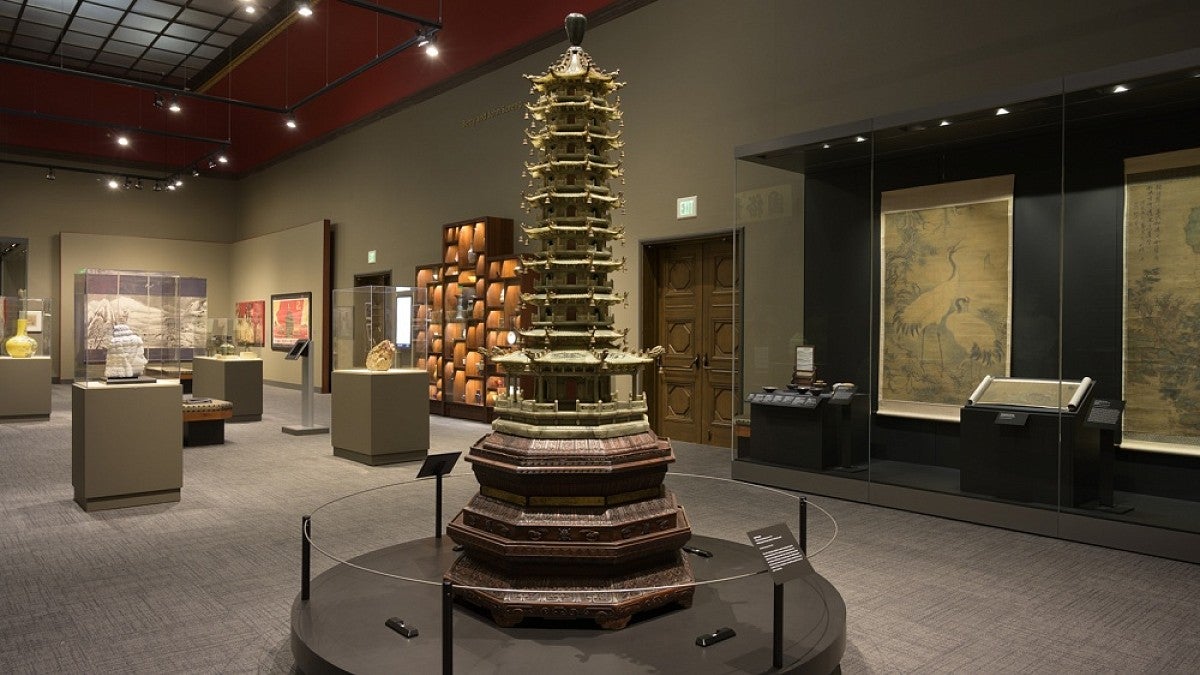More than 100 works of art spanning four millennia of Chinese history are included in the inaugural display “Myriad Treasures: Celebrating the Reinstallation of the Soreng Gallery of Chinese Art”at the UO’s Jordan Schnitzer Museum of Art.
The new exhibit draws from the legacy collection of museum founder Gertrude Bass Warner and selected recent acquisitions. It is the first to be staged in the museum’s Soreng Gallery since its recent renovation.
“This installation features a selection of the most breathtaking works in our historical Chinese collection, shown alongside stunning, thought-provoking works from the 20th and 21st centuries,” said John Weber, the museum’s executive director. “It offers great opportunities for faculty academic use and student study of the arts of China and strengthens the JSMA’s ability to engage both K-12 and university students.”
The inaugural display includes examples of the museum’s Qing dynasty court textiles, neolithic through 19th-century ceramics, ancient and archaistic bronze vessels, Buddhist art, literati and professional paintings, and prints of the 14th through 19th centuries, imperial calligraphy, elegant decorative objects made of jade, glass and crystal, and selected modern and contemporary Chinese paintings, posters and photographs.
Thanks to generous support from Betty Soreng and other anonymous donors, the museum was able to update the gallery floor, walls, casework and lighting.
“We are so happy and grateful to finally have displays worthy of our world-class Chinese collection,” said Anne Rose Kitagawa, chief curator of collections, Asian art and academic support. “The recent renovation makes it possible to show these important and beautiful artworks to great advantage and will enhance our visitors’ appreciation of 5,000 years’ worth of Chinese cultural achievement. We are deeply indebted the donors who made this possible.”
Arts from Asia were the foundation of the museum’s collection, thanks to founder Gertrude Bass Warner. After she was divorced in Chicago in 1903, she settled in Shanghai, where she remarried and amassed an Asian art collection of remarkable quality, complexity and depth.
Years later, she relocated to Eugene, where her son taught at the UO’s School of Law. There, she was inspired by the university’s academic mission to found the museum and donate her vast collection with the hope of fostering cross-cultural understanding and contributing to world peace.
When the University of Oregon Museum of Art opened in 1933, Warner dedicated the largest gallery to the display of Chinese art, a space that was lovingly referred to as the Throne Room.
Ten exquisite traditional Chinese textiles are featured in the new installation, ranging from imperial status garments to elegant women’s robes to richly embroidered military banners. One robe features the time-honored theme of One Hundred Children. These and other textiles from the museum’s collection were the subject of UO history professor Ina Asim’s recent Mellon grant-funded digital exhibition, the “Artful Fabric of Collecting.”
The gallery’s new casework made it possible to safely and attractively display examples of the museum’s distinguished collection of Chinese paintings, including one of the most beautiful Buddhist scrolls in the U.S., “Bhaiṣajyaguru, the Medicine Buddha with Bodhisattvas of the Sun and Moon and Twelve Guardian Generals,” plus major Ming dynasty landscapes.
Two recent gifts of major contemporary art collections — one from cutting-edge Chinese photography collectors Jack and Susy Wadsworth and the other of mixed-media works by Hung Liu from the artist and her late collaborator, master printer David Salgado — augmented the museum’s core collection of traditional Chinese art.
—By Debbie Williamson Smith, Jordan Schnitzer Museum of Art


